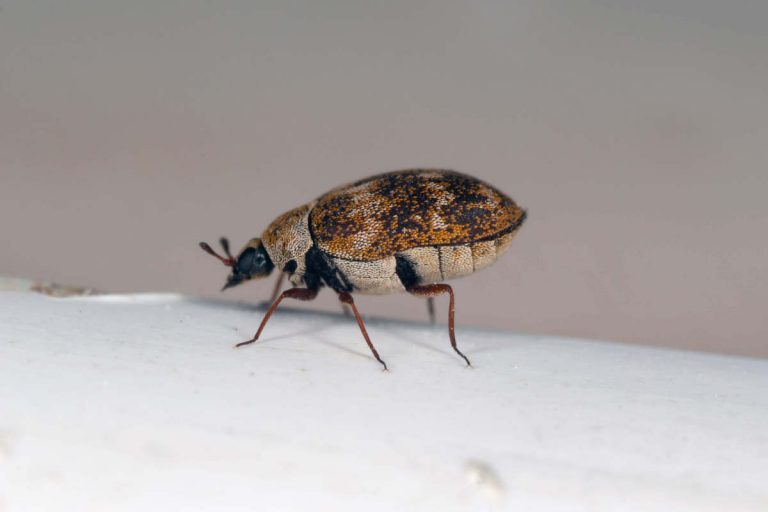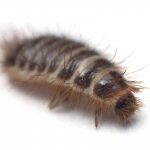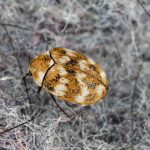A Guide to Identifying and Dealing with Carpet Beetles in Davis County
By Thorn Team • Mar 2nd 2022
Carpet beetles cause widespread pest issues for people all over the world.

They are found in homes, schools, warehouses, museums and other indoor spaces throughout the United States and are one of the most common indoor pests in our home state of Utah.
So, what causes carpet beetles? Where do they come from and how do you get rid of them?
CAUTION: Long-term exposure to carpet beetles and their larvae can cause certain individuals to become very sensitive to them. A rash and itching similar to an insect bite can develop. In severe cases, some individuals find that their eyes and throat may become irritated as well.
If you suspect a carpet beetle issue could be present in your home, don't wait until it becomes a serious problem! Deal with it promptly and use proper protective equipment such as long sleeves, a mask, gloves and eye protection, especially if you are sensitive to allergens or the infestation is severe.
What do Carpet Beetles Look Like?
While in their larval stage, carpet beetles look like hairy little worms, but what do carpet beetle adults look like?
The answer to this question varies slightly depending on what specific type of carpet beetle you're dealing with, but carpet beetle control is the same regardless of specifics.
Expect the following characteristics from a carpet beetle adult:
- An elongated, oval-shaped body, similar in shape to a ladybug
- Much smaller in size than a ladybug (anywhere from 1/16 to 1/8 inch in length)
- Varied coloring ranging from solid black or brown to speckles of white, black, brown, grey, yellow and orange


The Signs of Carpet Beetles
The name carpet beetle can be very misleading in more ways than one.
Carpet beetles are found in many different places and feed on many things, meaning carpets are just one of several items that could be at risk. Also, it's not the adult beetles doing the damage; it's their larvae.
The damage carpet beetle larvae cause to fabrics is often mistaken for clothes moth damage as both pests feed on a variety of natural fiber materials. Carpet beetles can also be found infesting pantry goods .
The term natural fiber applies to materials rich in keratin such as leather, skins, feathers, wool, felt, furs, silk or feathers. Keratin is an animal protein that is easily digested by carpet beetle larvae. Even small amounts of hair accumulating under furniture can provide enough keratin for a carpet beetle issue to become established.
Signs of a carpet beetle issue inside include:
- Adults inside, either flying or congregating around windows
- The presence of hairy larvae
- Accumulations of shed insect skins (larval or pupal)
- Damage to fabrics and other natural fiber materials
Lifecycle of the Carpet Beetle
When looking for a carpet beetle issue, you aren't just looking for adult beetles, you're looking for hairy little worms,also known as carpet beetle larvae.
Carpet beetles start as many pests do; in the form of a small egg. Female carpet beetles can lay over 100 eggs at a time and when these eggs (each around 1mm in diameter) hatch in 7-35 days, hairy little worms emerge ready to gobble through any keratin rich items they can find.
These larvae will spend anywhere from 9 months to two years eating, growing and pupating and will emerge as mature adults in the spring and summer months when their growth cycle is complete and they're ready to reproduce.
SOME QUICK ADVICE FROM THORN: Carpet beetles are often found accumulating inside near sunny windowsills during warmer months. Adult carpet beetles are capable fliers and, like many insects, are attracted to light. They emerge ready to fly to the nearest light source in search of the great outdoors, warmth and a mate. While one or two carpet beetles here and there is not necessarily something to be alarmed about, if you are regularly finding carpet beetles inside around your windows, you may want to start poking around for hairy worms and a more serious infestation.
3 Natural Ways to Get Rid of Carpet Beetles in Davis County
1. Inspect, Identify and Assess
When problem solving a pest issue, you want to use an integrated pest management (IPM) plan for ongoing solutions. In IPM, identification is the most important step in the process so that you can address the pest issue according to the pest's specific biology.
Inspect your home and make sure you're actually dealing with carpet beetles and not some other type of pest. Keep an eye open for samples of larvae or adults inside and save them if possible. Not only will saving a sample of the pest help you during your own research, but it will also help a pest control company if you end up needing professional assistance.
Common sources of carpet beetles include:
- Clothing made of natural fibers such as silk or fur
- Rugs or carpets made from natural fibers such as wool or felt
- Furniture (especially older furniture stuffed with animal hair)
- Pantry spills of flours, grains and other dried goods
- Nesting materials of birds, rodents and other animals
SOME QUICK ADVICE FROM THORN: Cotton and synthetic fibers are not likely to attract carpet beetle larvae unless they are blended with wool or heavily soiled with sweat, body oils or food stains. Make sure to keep laundry clean and properly stored to avoid furthering a carpet beetle issue. Take special items to the dry cleaner for regular cleaning and if you're planning to store anything made of natural fibers, consider vacuum-sealing them in bags to avoid pest infestation and damage.
2. Remove Carpet Beetle Sources
Once you have identified the source(s) of your carpet beetle issue, seek to remove and discard these items as soon as possible. This step can include looking in attic spaces or in your eaves for any old bird nests or wasp nests where adult carpet beetles could find a good, food-rich spot to lay their eggs.
Prepare yourself: If you're serious about keeping carpet beetles out, old furniture that is made of animal-sourced products such as leather or horsehair could be the problem. In these cases, the carpet beetles aren't likely to go away unless the furniture (the source) does.
Adopt a zero-tolerance policy when it comes to food infestations and dispose of any carpet beetle infested pantry items quickly to prevent the issue from spreading to other places in your home.
Remember that adult carpet beetles live outside. They are capable fliers that are, like many insects, attracted to light. Keeping your doors and windows open during the spring, summer or fall could allow carpet beetles to access your space, and keeping lights on can draw them in (especially at night). Unless your doors and windows have screens, try to keep them closed and turn lights off when not in use.
Adult carpet beetles' favorite food source is pollen. Carpet beetles are commonly found hiding in flowers where they can find a quick, tasty meal. Gently shake out flowers before bringing them inside, and don't keep them next to open windows where carpet beetles could enter looking for breakfast.
3. Tidy Up to Avoid Carpet Beetles Long-Term
Once the carpet beetle issue has been identified and the sources have been addressed, keep your home tidy to avoid carpet beetles.
Keep Carpet Beetles Out of Your Pantry
- If something spills in your pantry, clean it up quickly with a vacuum.
- Make sure to FIFO your dried food items to avoid a pantry pest issue.
- If you're seeing hairy little grubs in your baking goods, thoroughly inspect your goods to ensure no pests have infested them.
- Get rid of anything that shows signs of pantry pest damage.
Vacuum Like There's No Tomorrow!
The vacuum cleaner is your closest ally when it comes to carpet beetle control inside. Use the vacuum cleaner in all kinds of ways:
- Remove carpet beetle adults from your windowsills
- Regularly move furniture and vacuum, beds, couches and other furniture that is seldom moved
- Clean up carpet beetle larvae and shed skins from your carpets
SOME QUICK ADVICE FROM THORN: Vacuuming regularly, especially underneath furniture, is especially important if you have indoor pets. As pet hair (or human hair) accumulates underneath furniture, it creates an ideal spot for a carpet beetle to lay her eggs, where the larvae will have an abundant food source.
If you're located in Utah and you need help troubleshooting a carpet beetle issue, please feel free to contact Thorn in Davis County ! Our pest specialists would be happy to answer any pest control questions you may have.
About Thorn
Thorn is a Utah local pest management company. We are a QualityPro certified company which is a prestigious accreditation awarded to less than 3% of the pest management companies in the US.
Resources
About Thorn
Thorn is a Utah local pest management company. We are a QualityPro certified company which is a prestigious accreditation awarded to less than 3% of the pest management companies in the US.